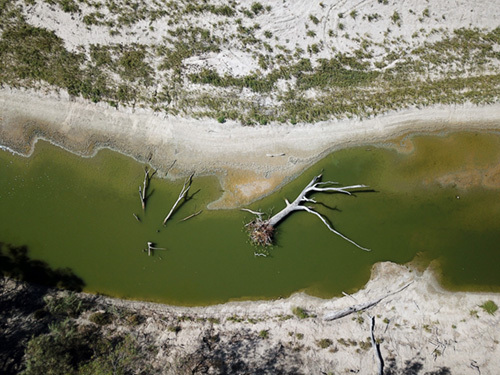- Winter 2023
- Climate change and the Basin Plan: where unlawful meets unethical

In January 2019, we saw scenes in the lower Darling (Baaka) River that looked like an Old Testament plague. A million dead fish. The Baaka, no longer a river, but a series of pools, full of toxic algae. Four years later, and the Baaka (and much of the Murray-Darling Basin) was in flood. And, once again, there were more than a million dead fish. Soon enough, the river will be in drought again. For how long, no one knows. Don’t think of these cataclysms as one-offs.
This is what the future looks like. There’s this notion that you hear, ‘Australia has always been a land of droughts and flooding rains and it will rain again and it will all be right’, and we hear that routinely. It lulls some people into a very dangerous false sense of security. Yes, it will rain again, yes this drought will break, but if droughts start lasting a little longer, start a little earlier – so instead of a three year drought, you get a five year drought, that’s catastrophic to people on the land. And we lull them into a false sense of security by the narrative we get from our senior decision makers. I think that’s really regrettable.
Those are the words of Professor Andy Pitman to Commissioner Bret Walker SC in the Murray-Darling Basin Royal Commission. He, and other experts, gave evidence on the topic of climate change in the context of the Murray-Darling Basin Plan. That evidence, supported by decades of peer reviewed science, led Walker to make a finding of ‘gross negligence’ against the Murray- Darling Basin Authority (MDBA) in respect to the drafting and implementation of the Basin Plan. In a report where findings of ‘negligence’ and ‘maladministration’ were made by the Commissioner on almost every critical aspect of the drafting of the Basin Plan, his strongest findings related to the way in which climate science was ignored. To best understand why this ‘risks decades of inertia’ (we are at eleven years of inertia as I write this), it’s first necessary to have some understanding of the Basin Plan itself, and what it sought to achieve.
The Murray-Darling Basin covers an area larger than France. It contains sixty percent of our farms, and our biggest river system. It is home to 16 ‘Ramsar’ listed wetlands – areas of huge ecological significance over which Australia has treaty obligations. We should care about the Basin because it is of enormous cultural, environmental, and economic significance.
By 2006 significant parts of the Basin were near environmental collapse. Two factors were at play: a changing climate (less run-off into the rivers), and decades of overallocation of water (by state governments) for the expansion of irrigated agriculture. Federal Parliament’s response to this was the Water Act 2007 (Cth). It includes the legislated facts that we have mismanaged the water resources of the Basin, and we are causing harm. It provided for a special measure to stop that harm: the Murray-Darling Basin Plan.

The goal of the Basin Plan is simple: some of the water allocated to irrigation will be returned to the environment. There will still be irrigated agriculture. Canberra did not command we go back to the conditions of 1788. Irrigators can still grow crops, but not so much that we wreck the joint. It’s amazing how much hostility there is to what seems like a reasonable idea. Many Australians are in favour of growing food and fibre through irrigation. And no one should be embarrassed if they prefer people to fish. But most Australians probably have a preference that we don’t take so much water that we risk killing our wetlands from the Coorong up.
How much more water the environment needs to stop its decline is a matter for scientists. Unsurprisingly then, the Water Act provides that the volume to be returned from consumptive uses is to be determined on (and only on) ‘the basis of the best available scientific knowledge’: s 21(4)(b) of the Water Act.
Anyone who follows the politics of water in this country knows that just because Canberra passes a law, it does not mean that Canberra thinks it should be bound to follow it. This is particularly so if unlawfulness is more convenient than legality. So the amount of water to be recovered under the Basin Plan, which the best science says should be in the range of 4000 to 7000 gigalitres a year on average (Sydney Harbour contains about 500GL), is now down to about 2100GL. This figure is not lawful. It closely represents a volume determined by politicians and bureaucrats after a pep talk from lobbyists. This aspect of ‘maladministration’ concerning the Plan is not what this article is about.
If you’re given the task of working out how much water the environment needs to be protected, even a person who is not science literate might think to ask this question: how much will it rain? More precisely, what will the inflows be to the rivers? The answer to this will almost certainly be wrong if you only look at how much it has rained in the past. So if you were deciding how much water to give to the environment as a maker of the Basin Plan in 2012, and you were determined to be wrong, you would focus on the weather data from 1895 to 2009. What that will tell you is that our weather has varied. Average inflows into the Basin are 12,000GL. But in 1974, and particularly 1956 (when inflows were 118,000GL) it bucketed down. Most years we are in drought. If an average is your thing, most years will benbelow it.
But if you’re making a water plan for the long term, and you want it to be useful, then one good question to ask is: what will inflows be in the coming decade, and perhaps the one after that?
In October 2008, the CSIRO published a report titled ‘Water Availability in the Murray- Darling Basin’. It informed us that it’s going to get hotter and dryer in most of the Basin in the decades to come. For every 1 degree Celsius the average daily temperature goes up (we are currently on track for a 3° to 4°C daily average rise), we will have 15% less run-off into our already hydrologically feeble rivers. Think about the Murray and the Darling in a state of drought. Then think about the state they will be in with forty-five percent less inflow than historical records.
When the MDBA was preparing the Basin Plan, the CSIRO told it that in doing its sums on the amount of water that has to go back to the rivers, ‘future climate scenarios’ need to be incorporated into the modelling.
The response from the MDBA to this advice from our leading scientific organisation? We’re going with how the weather was between 1895 to 2009 (my paraphrase).
The response from the CSIRO to this? Not including future climate projections into your modelling for the Basin Plan is ‘not scientifically defensible’. And without more water for the environment, ‘climate change will be likely to lead to irreversible ecological degradation’ (my paraphrase again, but the words in quotes are the CSIRO).
Consider this: the Basin Plan is a $13 billion (and rising) plan to save our environment. It is to be based on science. When it was being developed, the leading science agency of our government told the agency responsible for preparing it that it should include climate science in the modelling. It will not be ‘scientifically defensible’ if you don’t. And the other agency said to the CSIRO: ‘Stuff you’ (paraphrase).
That significant risk of ‘irreversible environmental degradation’ is coming in now. Ask the people who dealt with all those dead fish. Ask the traditional owners of the Baaka, and the Coorong.
I suppose it’s okay to appreciate the views that some prominent Australians either have or have had about climate change. Alan Jones has called climate change a ‘hoax’. Former PM Abbott called it ‘crap’. Senator Hanson has claimed climate change is caused by ‘the sun and the moon’. Andrew Bolt described it as a ‘myth’. However well informed these people are, none have qualifications in the fields of climatology, or computer modelling. But the practical effect of what the MDBA has done with climate science for the Basin Plan is to relegate that science to something as good as ‘myth’. Well before recent publications by the IPCC and other expert bodies over the last decade, the MDBA had crystal clear advice from our leading scientific research organisation that it ignored. Advice given at the level of: if you don’t do this, it’s scientifically indefensible. Even Australians who prefer people to fish are entitled to be outraged by that.
But if that conduct is outrageous, remember it happened ten years ago. Not one extra glass of water is currently proposed to be recovered for the environment as a result of all the climate science that has been published since the plan was enacted in 2012. Yet on current emissions trends, only if the laws of physics change will run-off into our rivers not continue to decline on average. Which is why, right now, we need to decide if we prioritise the environment (the parts we can save), or irrigated agriculture. You can’t do both. You can either put almonds first, or the trees and the fish. The Water Act, an ‘environment-first law’, prioritises the environment. Whether or not that’s a good thing is not the point of this article. The point is that by ignoring climate change projections when developing the Basin Plan, the MDBA as good as construed the Water Act as an ‘irrigators-first law’. That probably explains why Commissioner Walker made these findings about that approach in his Royal Commission report:
• ‘a head in the sand approach to the certainty of higher temperatures and less water in the Southern Basin’.
• ‘a slight on all those who live outside the Basin but who have an interest in either its economy or environment.. [and] includ[ing] anyone who pays tax’.
• ‘flawed from a standard risk management approach’.
• shows that ‘the MDBA has chosen to permit the environment to be disproportionately impacted’ to other users of water.
• ‘represents a failure to prepare the Basin Plan on the basis of the best available scientific knowledge’.
• not consistent with obligations in the Climate Change Convention.
• ‘unambiguously demonstrates the almost farcical approach to climate change by the MDBA’.
There was one word he did not use though. Professor Mark Howden, from the ANU and a member of the IPCC, told the Commissioner that downplaying the risks associated with climate change was ‘unethical as a scientist or as a policy decision-maker’.
That opinion went unchallenged.
Richard Beasley is the author of Dead in the Water (Allen & Unwin, 2021), which concerns the Murray-Darling Basin. BN
